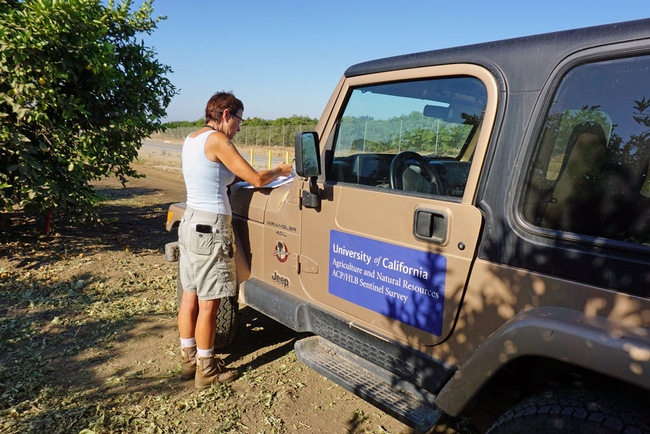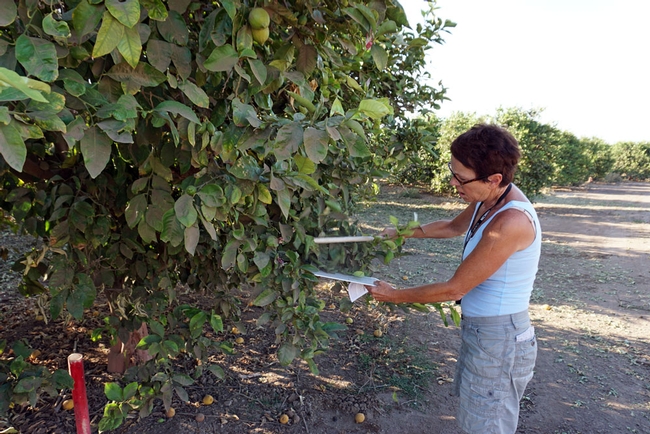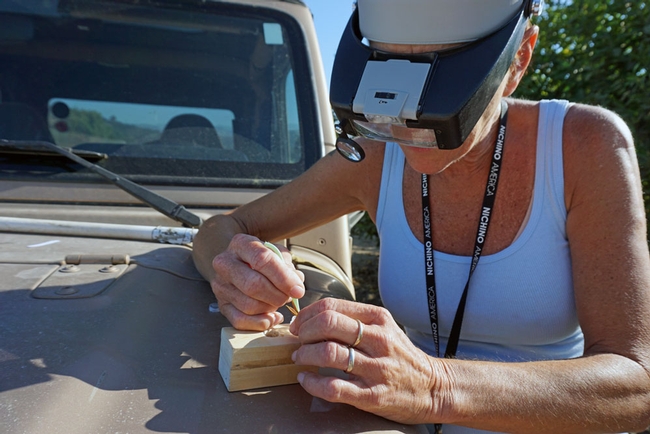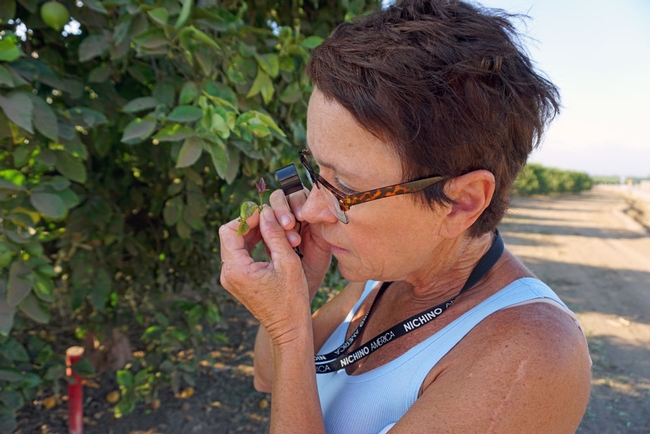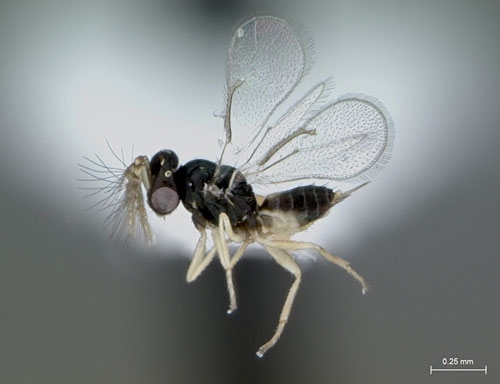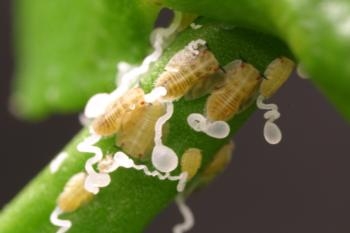Posts Tagged: huanglongbing disease
UC has boots on the ground in an unrelenting search for Asian citrus psyllid
With two magnifying loops around her neck and a truck stocked with vials and tools for insect collection, Joanne O'Sullivan scouts Ventura County citrus orchards every day. She walks the perimeter, examining newly emerging leaves and tapping branches with a PVC wand to bat pests onto her clipboard.
O'Sullivan is one of four scouts hired and trained by UC Agriculture and Natural Resources scientists to carefully and continuously monitor citrus orchards for Asian citrus psyllid, an invasive pest in California that can spread the devastating huanglongbing disease.
In Florida, where the pest was left unchecked when it first invaded citrus growing regions, the disease swept through the state. Citrus production in the Sunshine State plummeted 60 percent in 15 years.
“We don't want to let that happen here,” said Beth Grafton-Cardwell, UC Cooperative Extension entomology specialist. Grafton-Cardwell hired O'Sullivan and her colleagues who monitor citrus in San Diego, Imperial, Riverside and San Bernardino counties to scour dozens of orchards to document how treatments to control ACP are working. Next year scouts will be added in Tulare and Kern counties.
When ACP are found, they are carefully bottled and sent to the lab to determine whether they carry the bacterium that causes huanglongbing disease.
The expansive ACP monitoring effort is funded by a $1.45 million multi-agency coordination grant from the USDA. The project funds promising tools and long-term solutions to reduce the spread of huanglongbing. Led by Neil McRoberts, a professor of plant pathology at UC Davis, the grant also provides funds for two other activities.
One is a collaboration with California Citrus Mutual to offer free citrus tree removal to homeowners in areas where HLB is known to occur. The second is modeling data from the CDFA HLB survey program, in which psyllids and symptomatic plant tissue are tested for the bacteria. Trees may have the disease but not show symptoms, so testing the psyllids is a more effective way to find infected trees. The modeling work will improve the ability to predict the locations of infected trees.
However, the main thrust is monitoring citrus treatments and their impacts on the ACP population with a team of scouts. A mix of conventional and organic farmers and growers who use biological integrated pest management programs to manage their orchards were recruited for the project. The farmers make ACP treatment decisions informed by research results that show the best treatments and timing.
“Most growers are coordinating their treatments to get a bigger bang for their buck,” Grafton-Cardwell said.
With just six months of data, the monitoring program has already yielded important information about Asian citrus psyllid.
“We're seeing more psyllids on the borders than the centers of groves,” Grafton-Cardwell said. “And so eventually, we will make recommendations that at certain times of year or when populations are low, the grower will only need to spray the borders of the grove."
This will reduce costs and the impact of pesticides on natural enemies.
"The early data have also revealed which chemicals are the most effective for psyllid control. We've found that organic growers need to be more aggressive in the frequency of treatments, because the organic insecticides are not as effective as conventional insecticides," she said.
At 8 of the 49 Ventura County ranches in the project, yellow sticky traps were placed in trees to monitor for ACP's natural enemies, including lady bugs, green lacewings, and Tamorixia radiata, tiny wasps from Pakistan that were released in California to battle ACP.
When O'Sullivan sees one of the natural enemies at work in the field, she pauses to observe the process.
“Sometimes I'll see a lacewing munching on an ACP and I'll say, ‘Go man, go!'” O'Sullivan said.
Check Your Citrus Trees for Signs of This Pest
If you're a California commercial citrus grower or a homeowner with a citrus tree on your property, be sure to check for signs of the Asian citrus...
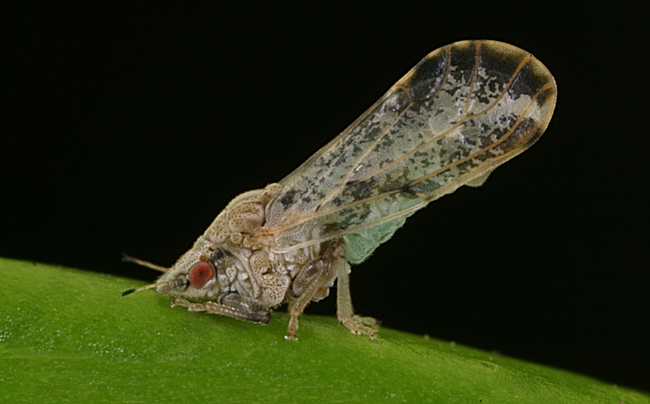
An adult Asian citrus psyllid. (Photo by M. Rogers)
Parasitic wasps battle Asian citrus psyllid
Western Farm Press ran a detailed update on efforts at UC Riverside to identify and release natural enemies of Asian citrus psyllid to aid in the fight against the feared citrus pest and the deadly citrus disease huanglongbing it carries in other parts of the U.S. and world.
To date more than 160,000 parasitic wasps have been released in over 400 locations spanning 350 zip codes, 64 cities and six counties in southern California, the story said. The counties are Los Angeles, Orange, San Bernardino, Riverside, San Diego and Imperial.
“What was remarkable was we had put out few parasites in relatively few areas (and) they survived just fine,” Hoddle said. “They came through their first winter here in southern California with no problem. That is always the first test: can they survive their first winter?”
Hoddle told Fitchette he is encouraged by the success of the program and by the biological success of the wasp. Since it was first released, it has developed its own breeding populations and has been discovered as far as eight miles away from initial release sites, indicating that it is quite mobile.
Hoddle cautions that the Tamarixia, and another parasitoid called Diaphorencyrtus aligarhensis (Encyrtidae), which could be released in California later this year, are not “silver bullets” in the Asian citrus psyllid/huanglongbing fight. Nevertheless, they do offer hope.
Commercial orchards will continue to spray for the ACP, but urban environments can employ biological control measures when the spray program operated by the state is too expensive to continue.
“As long as we maintain well-irrigated urban environments with plenty of citrus in them the Asian citrus psyllid is going to be here to stay,” he said.
San Diego County neighborhoods to be treated for Asian citrus psyllid
State officials will spray pesticide on residential citrus trees near Fallbrook today (Dec. 17), part of an ongoing effort across Southern California to prevent a devastating citrus disease, reported the San Diego Union Tribune.The pesticide application targets Asian citrus psyllid, which can transmit huanglongbing disease.
Residents in the area have been notified, said Steve Lyle, spokesman for the California Department of Food and Agriculture. He said officials have used the same preventive approach in San Diego County since 2008, when the pest was first discovered locally.
Union Tribune reporter Chris Nichols added information in the article from UC's Asian citrus psyllid and huanglongbing disease website.
"The Asian citrus psyllid is a brown insect about the size of an aphid. It attacks new citrus leaf growth and causes the new leaf tips to twist or burn back. Most concerning, it can spread bacteria that cause a citrus-greening disease known as Huanglongbing or HLB, according to a description on the University of California’s Agriculture and Natural Resources website," the reporter wrote.


